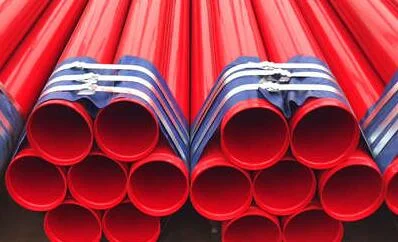Inspection process of plastic coated steel pipe inside and outside
The first is to inspect the appearance of the steel pipe. Appearance is the external performance of a product. In addition to its aesthetics, it is necessary to check whether its appearance quality is qualified and whether it meets the needs of product processing. Products that are damaged in appearance cannot pass the test.
Secondly, it is the measurement of product thickness. To measure the thickness, choose a standard measuring instrument. Take two cross sections of different lengths on the plastic-coated steel pipe. Use an electromagnetic thickness gauge to measure the coating thickness at any four points on the circumference of the cross section, and record Measurement results. Finally, compare whether the measurement results are consistent with the product standards.

In addition, it is to inspect the circuit of the plastic-coated steel pipe, take a certain length of pipe, and use the electric spark leak detector to check the steel pipe coating under the specified test voltage. The coating thickness and test voltage must meet the requirements, and the inspection No sparks are generated.
For the inspection of plastic-coated steel pipe, the most important thing is the inspection of its inner coating. There are many methods for the inspection of the inner coating, including bending test, flattening test, impact test, vacuum test, high temperature test, low temperature test, etc. Among them, the complete test and flattening test are carried out for different DN plastic coated steel pipes. In the experiment, a bending test was performed on the coated steel pipe with DN≤50mm, and the flattening test was performed on the coated steel pipe with DN>50mm.
The temperature conditions of the two experiments are basically the same, but the length and force of the weld are different. In the bending test, the weld is located on the side of the main surface of the bend, while in the flattening test, the weld is perpendicular to the direction of load application. After the test, inspect the inner coating of the plastic-coated steel pipe. For the impact test, the temperature and other conditions are basically the same as the previous two experiments, but the weld should be in the opposite direction of the impact surface. According to the requirements of the impact conditions, select a suitable impact test device for operation, and finally observe the damage of the inner coating, and Compare in accordance with relevant standards. The vacuum experiment is an experiment in which the inner coating is impacted by increasing the negative pressure in the tube, and then the inner coating is observed. Except for the difference in temperature selection, other conditions are basically the same for high temperature test and low temperature test.
There are many experiments to inspect the inner coating, including pressure cycle test, temperature cycle test, etc., users can choose by themselves.






